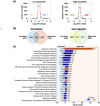ITIH4 alleviates OVA-induced asthma by regulating lung-gut microbiota
- PMID: 40410722
- PMCID: PMC12102971
- DOI: 10.1186/s10020-025-01270-x
ITIH4 alleviates OVA-induced asthma by regulating lung-gut microbiota
Erratum in
-
Correction: ITIH4 alleviates OVA-induced asthma by regulating lung-gut microbiota.Mol Med. 2025 Jun 25;31(1):248. doi: 10.1186/s10020-025-01293-4. Mol Med. 2025. PMID: 40563083 Free PMC article. No abstract available.
Abstract
Background: Inter-alpha-trypsin inhibitor heavy chain 4 (ITIH4), a Type 2 acute phase protein, is critical for resolving inflammation and promoting tissue repair. While its role in chronic respiratory diseases is recognized, its effects on asthma remain unclear. This study investigated the effects of ITIH4 on the modulation of lung and gut microbiota, the attenuation of allergic inflammation, and the improvement of respiratory outcomes in an asthma mouse model.
Methods: Six-week-old male Balb/c mice were divided into five groups: control, ITIH4, ovalbumin (OVA), and two OVA + ITIH4 treatment groups at different doses. Lung function and oxygen saturation were measured, and bronchoalveolar lavage fluid (BALF) was analyzed for white blood cell counts and cytokines. Lung and gut microbiota were profiled using 16 S rRNA gene sequencing, and short-chain fatty acids (SCFAs) were measured using gas chromatography-mass spectrometry (GC-MS). Proteomic profiling of intestinal tissues was conducted to identify ITIH4-associated signaling pathways.
Results: ITIH4 administration significantly mitigated OVA-induced asthma symptoms by reducing weight loss, airway resistance, and tissue damping (p < 0.05). Histological analysis showed decreased airway wall thickening and lung injury scores (p < 0.05). ITIH4 also lowered BALF eosinophils and lymphocytes, IgE, and Th2 cytokines (IL-4, IL-5, and IL-13) (p < 0.05). ITIH4 treatment modulated microbiome composition, enriching Gram-positive taxa (Nocardioidaceae and Acholeplasmataceae) and depleting Gram-negative Helicobacteraceae (p < 0.05). SCFAs correlated with microbiome alterations, notably reduced 4-methylpentanoic acid levels (p < 0.05). Proteomic analysis revealed a dose-dependent activation of granzyme A signaling and suppression of metabolic and solute transport pathways.
Conclusions: ITIH4 ameliorates asthma symptoms by modulating lung and gut microbiota, dampening Th2-driven inflammation, and restoring mucosal immune balance. These findings support ITIH4 as a potential candidate for microbiome-targeted asthma therapy.
Keywords: Airway hyperresponsiveness; Inflammation; Microbiome; Short-chain fatty acid; Th2.
© 2025. The Author(s).
Conflict of interest statement
Declarations. Ethics approval and consent to participate: All animal protocols were prepared in accordance with the Guide for the Care and Use of Laboratory Animals and were approved (IACUC: LAC-2021-0148) by the Laboratory Animal Center at Taipei Medical University (Taipei, Taiwan). Consent for publication: Not applicable. Competing interests: The authors declare no competing interests.
Figures







References
-
- Abrahamsson TR, Jakobsson HE, Andersson AF, Björkstén B, Engstrand L, Jenmalm MC. Low gut microbiota diversity in early infancy precedes asthma at school age. Clin Exp Allergy. 2014;44:842–50. - PubMed
-
- Ahmed AH, Galal MM, Eltrawy HH, Abdelaziz SY. Sputum bacterial identification in patients with bronchial asthma exacerbation. Al-Azhar Assiut Med J. 2020;18:440–8.
-
- Annoni R, Silva LFF, Nussbaumer-Ochsner Y, van Schadewijk A, Mauad T, Hiemstra PS, Rabe KF. Increased expression of granzymes A and B in fatal asthma. Eur Respir J. 2015;45:1485–8. - PubMed
MeSH terms
Substances
Grants and funding
LinkOut - more resources
Full Text Sources
Medical
Research Materials
Miscellaneous

